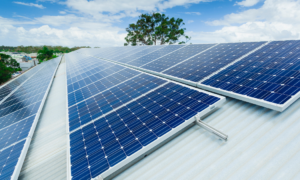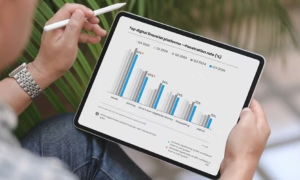While domestic solar has risen substantially across the UK in recent years, many households are still unsure whether it’s right for them or even if it’s just the right time.
But the reality is that many things have advanced in recent, such as the efficiency of solar panels themselves and the recent innovation of solar batteries.
So, how does solar fair in the current year?
The Current State of Domestic Solar
According to Solar Energy UK, 61,000+ UK properties had solar panels installed in 2021 with the total number of such properties now surpassing one million nationwide.
While this shows that solar panels are becoming more popular, estimates suggest that the number of households with such installations is under 4%. So clearly there’s still a long way to go.
In 2023, an average 5kW system (for a household of about four people) would likely cost between £9,000 and £11,000 to install. While this price tag may put off most properties as it may be an unaffordable expense, there are alternatives to paying the full cost upfront, which we’ll discuss in more detail later.
However, even if you can afford the installation, is it even worth it and do solar panels pay for themselves with time?
Of course, since solar energy is free, the obvious financial benefit they offer is that they can reduce or potentially eliminate your energy bills. In most cases, solar panels will be used to contribute to a household’s energy needs as opposed to meeting them entirely.
Cost By Property Size and Cost Factors:
Before we get into that, it’s important to consider the average instalment costs based on property size:
| Size of System | No. of Panels | Cost of Labour | Standalone Cost of Panels | Overall Cost |
| 3 kW | 12 | £600 to £1,000 | £5,000 to £6,000 | £5,600 to £7,000 |
| 4 kW | 16 | £600 to £2,000 | £6,000 to £7,000 | £6,600 to £9,000 |
| 5 kW | 20 | £1,200 to £2,000 | £8,000 to £9,000 | £9,200 to £11,000 |
| 6 kW | 24 | £1,200 to £3,000 | £8,000 to £10,000 | £9,200 to £13,000 |
Aside from the size of property/number of panels required, the cost may also be affected by the type of panels used (i.e., the material), accessibility to the roof and the location of your property. With regards to the last point, location is relevant since labour costs differ across the UK.
Do Solar Panels Pay for Themselves with Time?
In general, solar panels should pay for themselves eventually. However, this is not guaranteed. Solar panels tend to last for around 25-30 years, so in order for panels to pay for themselves, they’d likely need to do so within this timeframe.
Considering that a solar panel array is estimated to save somewhere between £150 and £450 in annual electric bills (depending primarily on the size of the system *), most solar panel installations are likely to pay for themselves but again there’s no guarantee. What’s more, small solar arrays are less likely to pay for themselves.
In most cases, a solar array will pay for itself within 15-25 years. Therefore, if it does pay for itself, it may only do so several years before reaching a point where they’d need replacing.
That is unless you find relatively affordable panels that last longer than most or through a mix of ensuring your panels are well-maintained and a bit of luck, they last many years longer than expected.
However, even if solar panels are likely to only just about pay for themselves, there are more advantages to such an installation than saving on energy bills.
*Aside from the size of the property, how much you’d actually save you depend on what your current bills are.
What Other Advantages Do Solar Panels Offer?
While a solar array is likely to reduce your annual energy bills, it can provide a range of other benefits, which we’ll discuss in this section.
Selling Power Back to the Grid
Not only can solar panels lower your electricity bills, but they can even make you money. Due to the Smart Export Guarantee (SEG), some energy providers are mandated by law to purchase solar energy from regular households so long as certain criteria are met.
Currently the UK’s mandatory SGE licensees are:
- E
- British Gas
- OVO Energy
- EDF
- The Utility Warehouse
- ON
- Scottish Power
- Shell Energy
- Octopus Energy
- ESB
- Utilita
Beyond that there are also a range of voluntary SEG licensees. Each licensee can set aspects of their plans. While tariff rates (how much you’d receive from the energy provider for any given kW of electricity) tend to land between 2p and 6p per kW, Tesla offers as much as 12p per kW.
Tariff rates tend to vary 2.0p per kW and 6.0p per kW, although Tesla offers up to 12.0p per kW. As for whether or not they must be on the supplier import tariff, this varies greatly.
For instance, Octopus Energy and SSE must be on the supplier import tariff. On the other hand, this isn’t the case for OVO Energy, ScottishPower or British Gas.
Less Stress Over Bills
While it’s true that you’d need to splash out thousands on a solar array installation, the benefit of facing lower electricity bills over time could be a great relief, particularly when electricity prices are going up.
Lowers Your Carbon Footprint
Solar panel is, of course, a zero-carbon means of generating electricity. Therefore, by having solar panels fitted to your roof you can significantly lower your carbon footprint while playing your role in contributing to the reduction of the national carbon footprint.
Alternative Payment Methods
If the cost of a solar panel installation is realistically outside your budget, you may be interested in considering an alternative payment method. However, it is important to note that you should not take on debt unless you are sure you’ll be able to comfortably make the repayments on time.
Here are some alternatives to simply purchasing solar panels upfront:
Purchasing on Finance
First up, if you are lucky, you may find a company offering a buy now, pay later plan for a solar panel installation.
This would involve having solar panels installed while paying off the cost of the installation (which would include the price of labour and supply cost) over a prolonged time frame, potentially ranging from one year to several years or more.
These plans are not extremely common, however, so there’s a reasonable chance that you won’t find a suitable offer in your area. With that said, if this option interests you, it’s worth a look. Obviously, you’ll want to pay attention to the interest rate (if applicable) of any given plan and any notable terms and conditions.
- Taking A Loan Out – A similar approach to paying for a solar panel array is to take out a loan. Given the cost of an average solar system, this won’t be as easy as getting approval for a relatively small loan of say £500 or £1,000. Good credit history will likely be required (at least for the past several years) and interest will almost certainly apply.
- Paying With a Credit Card – The last payment option that involves taking on debt is to pay with a credit card. Again though, you should proceed with caution if one of these approaches interests you. If in doubt, wait until solar panels are more affordable or/and you are in a stronger financial position down the line.
- Grants/Funding – Some properties may be able to benefit from a grant/funding to reduce or eliminate the cost of a solar panel installation. Popular schemes that you may be eligible for include the ECO+ and ECO4 schemes which are designed to increase the energy efficiency of households. The ECO4 scheme is more specific to vulnerable and energy inefficient properties. However, while ECO+ has a broader reach, if you aren’t eligible for either of these schemes, sometimes councils can still provide funding in the form of LA FLEX (Local Authority Flexibility) funding. This funding can be used to support households without the resources to significantly alter their property but who are not technically eligible for either of the ECO schemes. Some local councils also provide regional grants. For more details on grants/funding you may be eligible for, contact your local council.
Don’t Forget the Suitability of Your Home
Another key consideration to take on board with regards to the worthiness of investing in a solar panel array is whether or not your home is actually suitable.
For one, assuming that you wish to have a roof-based solar array installed, you’d need to consider what the state of your roof and what direction it faces.
A roof obviously must be sufficient to safely bear the load of a solar panel installation. This is something that an MCS certified installer can determine for you. Of course, if it is not, that doesn’t rule out the possibility of an installation since you could have work undertaken to make your roof suitable but obviously that would be an additional expense.
As for the direction that the roof faces, the ideal roof is one that is south facing as this will have access to the most sunlight. However, if your roof is east- or west-facing the suitability of a solar installation declines. It may still be worth it, but you’d need to take this into account.
Beyond that, north-facing roofs are not suitable for a solar panel installation due to the lack of solar energy these roofs see throughout the year. However, if it is your back roof that faces north, do keep an open mind about the possibility of fitting solar panels to your front roof. Perhaps surprisingly, planning permission is often still not required even for a front facing solar array so long as other criteria are met.
Lastly, you’ll want to consider whether or not a solar system fitted to your roof would be obscured. If there are nearby buildings or/and trees that may block sunlight to a substantial degree then, at the very least, a roof-based solar array may not be worthwhile in your case.
However, there is an alternative to having solar panels fitted to your roof. Let’s say you have a north-facing back roof and wouldn’t dream of adding solar panels to the front of your house. If you have an open space at the back of your property (and preferable you live in a rural area with few sources to block sunlight), you may want to consider a ground-mounted solar array.
While ground-mounted solar panels may cost more, they offer an array of advantages (e.g., easier to maintain and you’d have the option of creating a tracking system capable of following the sun throughout the day) and may prove suitable for properties where a roof-based system is not desired or is simply unfeasible.
The Best Solar Panels to Purchase in 2023
There are, of course, a wide range of solar panels on the UK market, therefore choosing the right product can be a challenge.
With that said, some brands stand out more than others with companies like SunPower, Project Solar, Panasonic, LG and Jinko Solar producing some of the very best panels on the market.
Here are our favourite solar panels that you may want to buy in 2023:
| Product | Power | Efficiency | Cost per Panel |
| SunPower Maxeon 3 | 370 to 400 watts | 20.9% to 22.6% | £300 to £350 |
| Project Solar Evolution Elite 400 | 395 to 415 watts | 22% | N/A |
| LG NeON R | 350 to 440 watts | 8% to 22.3% | From £300 |
| Jinko Solar Tiger Neo 72HL4 | 550 to 575 watts | 26% | £200 to £350 |
| Project Solar Evolution Ultramax | 345 watts | N/A | Bespoke quotes |
When finding the right solar panel for you, you’ll want to consider a range of qualities. Along with the power output and efficiency of the panels you’re considering, don’t forget to pay close attention to the warranties offered.
There are two types of solar warranty, those being guarantees for the equipment itself and performance guarantees (i.e., cover for the power output of your solar panels lasting for X amount of time).
Aside from spending time finding the right solar panel product for you, it’s best to obtain quotes from at least three MCS certified installers or solar installation companies if possible. That way you’d have plenty of options to consider before choosing the right person/company for you.
For more details on these panels and other high-quality top-of-the-market options, check out this guide.
So, Are Solar Panels Worth the Investment?
Overall, solar panels are arguably worthwhile. Not only is the average solar panel array likely to pay for itself eventually, but solar panels can also offer a range of additional benefits including the potential to sell energy back to the grid.
With that being said, while solar panels are, in our view, worth the investment in most cases, this doesn’t mean this will always apply. If you use a lot of electricity and only plan on having a small solar panel array installed, it may not be worth it.
What’s more, if you do not have the budget and are not in a suitable position to avail of alternative payment method, you’ll want to pass on a solar installation, for now at least.
Even if a solar panel installation isn’t worth it for you right now, prices are expected to continue to drop in the years ahead. Therefore, as times passes, a solar installation will be worth the investment for more and more properties.



































